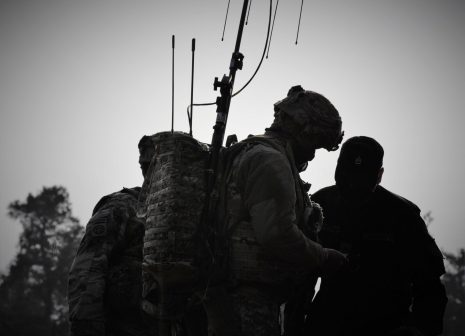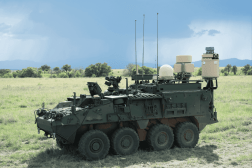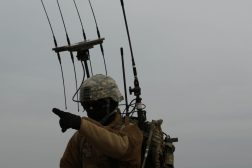Army shifts procurement funding for integrated cyber, EW and signals intelligence platform

The Army has adjusted procurement funding for its first integrated cyber, electronic warfare and signals intelligence platform, requesting a nearly 58% decrease in fiscal 2024 relative to previous projections — due in large part to prioritizing the equipment for infantry units.
Budget documents released last year projected the Army requesting $201.1 million in fiscal 2024 for procurement of the Terrestrial Layer System-Brigade Combat Team, which is the first brigade-organic integrated signals intelligence, electronic warfare and cyber platform that will first be mounted on Strykers. It is part of a family of systems that also includes the TLS-Echelons Above Brigade, which is designed for higher echelons that will need to monitor and sense the battlefield across greater distances than lower, more tactically focused echelons.
However, the recently released fiscal 2024 budget request includes just $84.6 million for TLS-BCT procurement.
“This funding change was in response to an adjustment in the program’s Middle-Tier Acquisition Rapid Prototyping strategy to prioritize and accelerate the fielding of capability to [infantry brigade combat teams],” Ken Strayer, project manager for electronic warfare and cyber at Program Executive Office Intelligence, Electronic Warfare and Sensors, said in a statement to DefenseScoop. “The cost to equip an IBCT with a TLS-BCT manpack solution is lower than either the Stryker BCT or Armored BCT solutions.”
At the end of the Cold War, the Army divested much of its electronic warfare inventory. As a result, the service doesn’t have any program-of-record jamming capabilities and has historically relied upon quick reaction capabilities that fill gaps identified by commanders. These have consisted of the dismounted Versatile Radio Observation and Direction (VROD) and VROD Modular Adaptive Transmission system (VMAX) — the former surveys the field from an electromagnetic perspective, and the latter provides a limited electronic attack capability.
When it comes to developing programs of record, the Army is prioritizing filling immediate gaps.
The service has created a requirement for a dismounted capability associated with TLS-BCT that will be a manpack version. Officials have said soldiers will be able to take a backpack off the platform for dismounted operations.
Last year’s budget request for fiscal 2023 sought to procure six TLS-BCT systems, while projecting a 25 system spend in fiscal 2024. However, the new 2024 budget blueprint is requesting 56 total systems — 52 are the manpack version and the remaining four are for the Stryker production.
Fiscal 2024 funding would also go toward contract management required for an urgent operational needs statement for V Corps in support of the European Deterrence Initiative, budget documents state.
Strayer emphasized that the decrease in requested procurement funding does not equate to a slip in program schedule.
“The program is on-schedule for an Operational Demonstration in September 2023 that will inform the production and fielding decision. Additionally, the added [research, development, test and evaluation] funding will support the FY24 integration of the TLS BCT mission payload onto the Army’s new Armored Multi-Purpose Vehicle (AMPV) for Armored BCTs,” he told DefenseScoop.
“Additionally, a portion of this OPA reduction was shifted to the program’s FY24 RDTE request. This will allow the Army to issue the prototype Stryker-based systems to an operational unit in FY24 in support of more expansive operational testing prior to commitment to production and full fielding,” Strayer said.
The Army has yet to release budget justification books for research, development, test and evaluation with the new five-year spending projections.
The 2024 budget request included $859,000 for procurement for TLS-EAB, which was a new start this year regarding procurement under the TLS line item.
Requested funding would also go toward the planning for procurement of some of the most critical long lead items required for the initial TLS-EAB production systems, budget documents state. Last summer, the Army awarded Lockheed Martin and General Dynamics Mission Systems contracts to do design work, which includes software infrastructure and vehicle design worth approximately $15 million over an 11-month period of performance.
Both companies recently declined to provide updates to DefenseScoop on their efforts ahead of the Army’s award.






